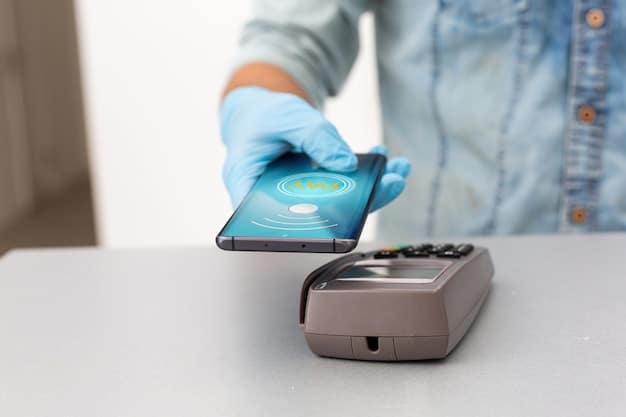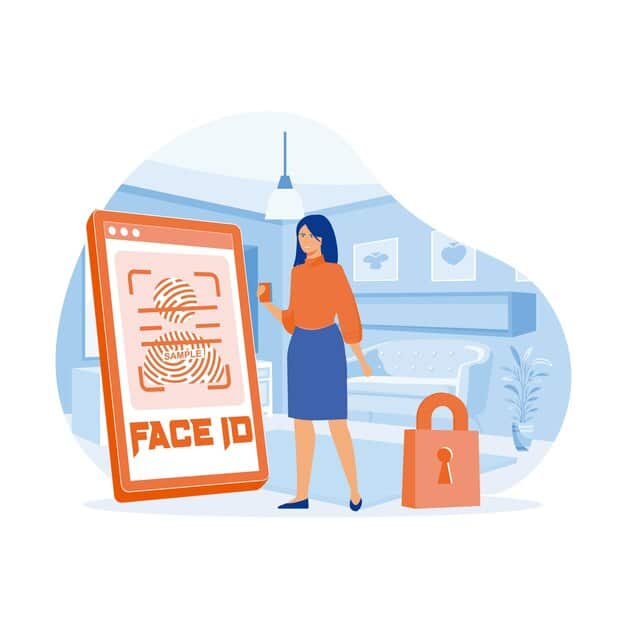Biometric Payments: The Future of US Digital Transactions

Digital payment trends in the US increasingly rely on biometric authentication to enhance security, streamline transactions, and meet growing consumer expectations for seamless experiences.
The landscape of digital payments in the United States is undergoing a significant transformation, driven by technological advancements and evolving consumer demands. Among the key digital payment trends, biometric authentication stands out as an increasingly essential component for securing transactions and enhancing user experience.
The Rise of Biometric Authentication in US Digital Payments
Biometric authentication is rapidly gaining traction in the US digital payments ecosystem. This technology leverages unique biological traits to verify a user’s identity, adding an extra layer of security to transactions. As fraud and cyber threats become more sophisticated, biometric methods offer a more reliable and user-friendly alternative to traditional passwords and PINs.
What is Biometric Authentication?
Biometric authentication involves identifying individuals based on their unique biological characteristics. This can include fingerprint scanning, facial recognition, iris scanning, and even voice recognition. These methods offer a higher level of security because they are difficult to replicate or counterfeit.
How Biometric Payment Systems Work
The process generally involves enrolling a user’s biometric data, such as a fingerprint or facial scan, which is then securely stored on a device or in a secure server. During a transaction, the user provides their biometric data, which is compared to the stored template for verification. If the match is successful, the transaction is authorized.

Here are some benefits of using biometric authentication:
- Enhanced Security: Biometric data is unique and difficult to replicate, reducing the risk of fraud.
- Improved User Experience: Biometric authentication is faster and more convenient than traditional methods.
- Compliance with Regulations: Biometric authentication can help businesses comply with data protection and privacy regulations.
In summary, biometric authentication is revolutionizing digital payments in the US by offering enhanced security and improved user experiences.
Key Biometric Technologies Transforming Payments
Several biometric technologies are at the forefront of transforming digital payments in the US. Each offers unique advantages and applications, contributing to a more secure and seamless transaction environment. These technologies are not only enhancing security but also improving the speed and convenience of digital payments.
Fingerprint Scanning
Fingerprint scanning is one of the most widely adopted biometric technologies in digital payments. It involves using a fingerprint reader to capture and verify a user’s fingerprint. This method is integrated into smartphones, tablets, and payment terminals, making it easily accessible to consumers.
Facial Recognition
Facial recognition uses cameras to identify and verify users based on their facial features. This technology is becoming increasingly common in mobile payment apps and at point-of-sale systems. Facial recognition offers a contactless payment option, which is particularly appealing in a post-pandemic world.
Other biometric technologies include:
- Iris Scanning: Uses the unique patterns in the iris of the eye for identification, offering a high level of security.
- Voice Recognition: Verifies a user’s identity based on their voice, providing a hands-free payment option.
- Behavioral Biometrics: Analyzes a user’s behavior, such as typing speed and mouse movements, to detect fraudulent activity.
Overall, these technologies are significantly enhancing the security and convenience of digital payments in the US.
The Impact of Biometrics on Mobile Payments in the US
Mobile payments have become increasingly popular in the US, and biometric authentication is playing a crucial role in their growth and security. By integrating biometric technologies, mobile payment platforms are providing users with a more secure and convenient way to transact.
Enhanced Security for Mobile Wallets
Mobile wallets like Apple Pay, Google Pay, and Samsung Pay have embraced biometric authentication to protect users’ financial information. Fingerprint scanning and facial recognition are commonly used to verify transactions, reducing the risk of unauthorized access and fraud.
Streamlined User Experience
Biometric authentication simplifies the mobile payment process. Users can quickly authorize transactions with a touch or a glance, eliminating the need to enter passwords or PINs. This streamlined experience encourages greater adoption and usage of mobile payment platforms.

The benefits of biometrics in mobile payments include:
- Faster and more convenient transactions
- Reduced risk of fraud and identity theft
- Improved customer satisfaction
In conclusion, biometric authentication is essential for securing and enhancing the mobile payment experience in the US.
Consumer Adoption and Trust in Biometric Payments
Consumer adoption and trust are critical factors in the widespread acceptance of biometric payments. As more consumers become familiar with biometric technologies, their level of trust and willingness to use these methods for transactions increases. Understanding consumer perceptions and addressing concerns is essential for driving adoption.
Factors Influencing Adoption
Several factors influence consumer adoption of biometric payments. These include the perceived security of biometric methods, the convenience they offer, and the level of trust consumers have in the technology. Education and awareness campaigns can help address misconceptions and promote the benefits of biometric authentication.
Addressing Security and Privacy Concerns
Security and privacy concerns are common barriers to adoption. Consumers want to know that their biometric data is securely stored and protected from unauthorized access. Transparent data policies and robust security measures are essential for building trust and encouraging adoption.
Strategies for enhancing consumer trust include:
- Implementing transparent data policies
- Using advanced encryption techniques
- Providing clear explanations of how biometric data is used
Overall, building consumer trust and addressing security concerns are crucial for the widespread adoption of biometric payments in the US.
Regulatory Landscape and Compliance in the US
The regulatory landscape plays a significant role in shaping the adoption and implementation of biometric authentication in digital payments. Compliance with data protection and privacy regulations is essential for businesses that use biometric technologies. Understanding the regulatory requirements in the US is crucial for ensuring responsible and ethical use of biometrics.
Key Regulations and Standards
Several regulations and standards govern the use of biometric data in the US. These include the Biometric Information Privacy Act (BIPA) in Illinois, which sets strict requirements for the collection, storage, and use of biometric information. Other states have similar laws, and businesses must comply with these regulations to avoid legal liabilities.
Ensuring Compliance
To ensure compliance with biometric regulations, businesses must implement robust data protection measures and transparent privacy policies. This includes obtaining consent from users before collecting their biometric data, securely storing the data, and limiting its use to authorized purposes.
Best practices for compliance include:
- Conducting regular security audits
- Implementing data encryption and access controls
- Providing clear and transparent privacy policies
In summary, navigating the regulatory landscape and ensuring compliance are essential for the responsible and ethical use of biometric authentication in digital payments.
Future Trends and Innovations in Biometric Payments
The future of biometric payments is bright, with ongoing innovations and emerging trends promising to further enhance security and user experience. As technology evolves, new biometric methods and applications are likely to emerge, transforming the way we transact in the digital age. Staying abreast of these trends is essential for businesses and consumers alike.
Emerging Biometric Technologies
Several emerging biometric technologies are poised to revolutionize digital payments. These include vein recognition, which uses the unique patterns of veins in the hand or finger for identification, and cardiac biometrics, which analyzes the unique electrical activity of the heart.
Integration with IoT Devices
The integration of biometrics with Internet of Things (IoT) devices is another exciting trend. This could enable seamless and secure payments through smart devices like wearables, smart home appliances, and connected cars. Imagine paying for groceries with a simple gesture or authorizing a payment with your voice through your smart speaker.
Future possibilities in biometric payments include:
- More secure and convenient payment methods
- Greater personalization and customization
- Enhanced fraud prevention capabilities
Looking ahead, the future of biometric payments promises to be both exciting and transformative, with ongoing innovations paving the way for a more secure and seamless digital transaction environment.
| Key Point | Brief Description |
|---|---|
| 🔒 Enhanced Security | Biometrics offer unique, hard-to-replicate authentication. |
| 🚀 Streamlined Transactions | Faster, more convenient payments without passwords. |
| 📱 Mobile Payment Integration | Biometrics secure mobile wallets and simplify user experience. |
| 🛡️ Regulatory Compliance | Adhering to data protection laws ensures responsible biometric use. |
Frequently Asked Questions
▼
Common methods include fingerprint scanning, facial recognition, iris scanning, and voice recognition, each offering unique security and convenience features.
▼
Biometric authentication is generally more secure as it relies on unique biological traits that are difficult to replicate or steal, reducing fraud risk.
▼
Key benefits include enhanced security, faster transactions, improved user experience, and compliance with data protection regulations.
▼
Yes, privacy concerns exist regarding data collection and storage. Addressing these concerns with transparent policies and robust security measures is crucial.
▼
Regulations like BIPA in Illinois set strict standards for biometric data handling, requiring businesses to comply with privacy laws to avoid legal liabilities.
Conclusion
In conclusion, biometric authentication is not just a trend but a fundamental shift in how digital payments are secured and experienced in the US. As technology advances and consumer trust grows, biometric payments are poised to become the norm, offering a more secure, convenient, and seamless way to transact in the digital age.





